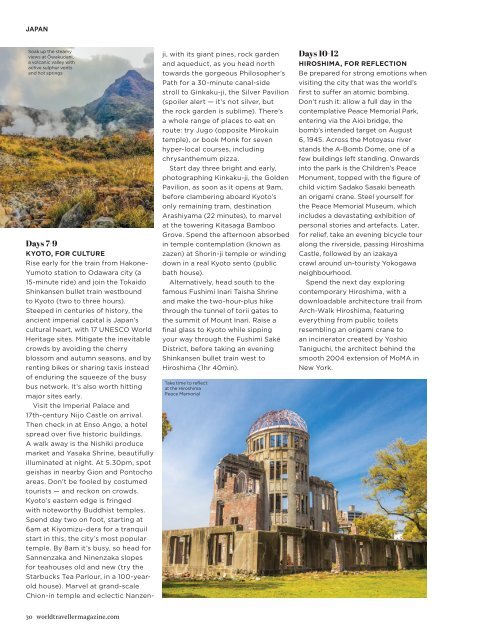You also want an ePaper? Increase the reach of your titles
YUMPU automatically turns print PDFs into web optimized ePapers that Google loves.
JAPAN<br />
Soak up the steamy<br />
views at Ōwakudani,<br />
a volcanic valley with<br />
active sulphur vents<br />
and hot springs<br />
Days 7-9<br />
KYOTO, FOR CULTURE<br />
Rise early for the train from Hakone-<br />
Yumoto station to Odawara city (a<br />
15-minute ride) and join the Tokaido<br />
Shinkansen bullet train westbound<br />
to Kyoto (two to three hours).<br />
Steeped in centuries of history, the<br />
ancient imperial capital is Japan’s<br />
cultural heart, with 17 UNESCO <strong>World</strong><br />
Heritage sites. Mitigate the inevitable<br />
crowds by avoiding the cherry<br />
blossom and autumn seasons, and by<br />
renting bikes or sharing taxis instead<br />
of enduring the squeeze of the busy<br />
bus network. It’s also worth hitting<br />
major sites early.<br />
Visit the Imperial Palace and<br />
17th-century Nijo Castle on arrival.<br />
Then check in at Enso Ango, a hotel<br />
spread over five historic buildings.<br />
A walk away is the Nishiki produce<br />
market and Yasaka Shrine, beautifully<br />
illuminated at night. At 5.30pm, spot<br />
geishas in nearby Gion and Pontocho<br />
areas. Don’t be fooled by costumed<br />
tourists — and reckon on crowds.<br />
Kyoto’s eastern edge is fringed<br />
with noteworthy Buddhist temples.<br />
Spend day two on foot, starting at<br />
6am at Kiyomizu-dera for a tranquil<br />
start in this, the city’s most popular<br />
temple. By 8am it’s busy, so head for<br />
Sannenzaka and Ninenzaka slopes<br />
for teahouses old and new (try the<br />
Starbucks Tea Parlour, in a 100-yearold<br />
house). Marvel at grand-scale<br />
Chion-in temple and eclectic Nanzen-<br />
ji, with its giant pines, rock garden<br />
and aqueduct, as you head north<br />
towards the gorgeous Philosopher’s<br />
Path for a 30-minute canal-side<br />
stroll to Ginkaku-ji, the Silver Pavilion<br />
(spoiler alert — it’s not silver, but<br />
the rock garden is sublime). There’s<br />
a whole range of places to eat en<br />
route: try Jugo (opposite Mirokuin<br />
temple), or book Monk for seven<br />
hyper-local courses, including<br />
chrysanthemum pizza.<br />
Start day three bright and early,<br />
photographing Kinkaku-ji, the Golden<br />
Pavilion, as soon as it opens at 9am,<br />
before clambering aboard Kyoto’s<br />
only remaining tram, destination<br />
Arashiyama (22 minutes), to marvel<br />
at the towering Kitasaga Bamboo<br />
Grove. Spend the afternoon absorbed<br />
in temple contemplation (known as<br />
zazen) at Shorin-ji temple or winding<br />
down in a real Kyoto sento (public<br />
bath house).<br />
Alternatively, head south to the<br />
famous Fushimi Inari Taisha Shrine<br />
and make the two-hour-plus hike<br />
through the tunnel of torii gates to<br />
the summit of Mount Inari. Raise a<br />
final glass to Kyoto while sipping<br />
your way through the Fushimi Saké<br />
District, before taking an evening<br />
Shinkansen bullet train west to<br />
Hiroshima (1hr 40min).<br />
Take time to reflect<br />
at the Hiroshima<br />
Peace Memorial<br />
Days 10-12<br />
HIROSHIMA, FOR REFLECTION<br />
Be prepared for strong emotions when<br />
visiting the city that was the world’s<br />
first to suffer an atomic bombing.<br />
Don’t rush it: allow a full day in the<br />
contemplative Peace Memorial Park,<br />
entering via the Aioi bridge, the<br />
bomb’s intended target on August<br />
6, 1945. Across the Motoyasu river<br />
stands the A-Bomb Dome, one of a<br />
few buildings left standing. Onwards<br />
into the park is the Children’s Peace<br />
Monument, topped with the figure of<br />
child victim Sadako Sasaki beneath<br />
an origami crane. Steel yourself for<br />
the Peace Memorial Museum, which<br />
includes a devastating exhibition of<br />
personal stories and artefacts. Later,<br />
for relief, take an evening bicycle tour<br />
along the riverside, passing Hiroshima<br />
Castle, followed by an izakaya<br />
crawl around un-touristy Yokogawa<br />
neighbourhood.<br />
Spend the next day exploring<br />
contemporary Hiroshima, with a<br />
downloadable architecture trail from<br />
Arch-Walk Hiroshima, featuring<br />
everything from public toilets<br />
resembling an origami crane to<br />
an incinerator created by Yoshio<br />
Taniguchi, the architect behind the<br />
smooth 2004 extension of MoMA in<br />
New York.<br />
30 worldtravellermagazine.com

















